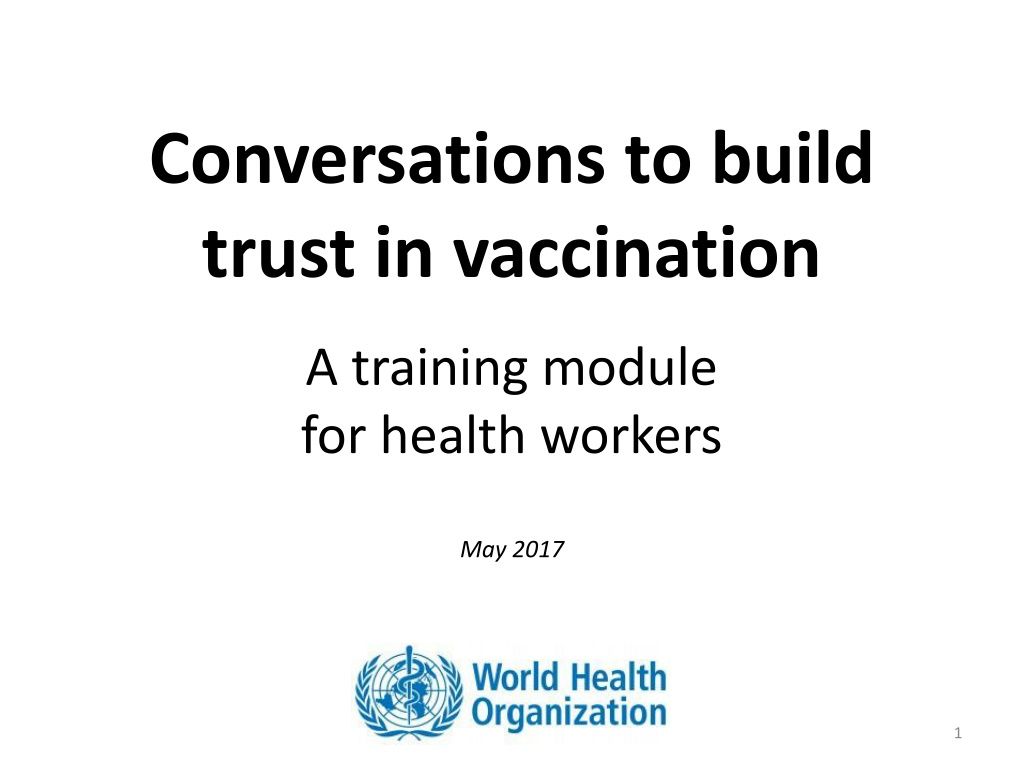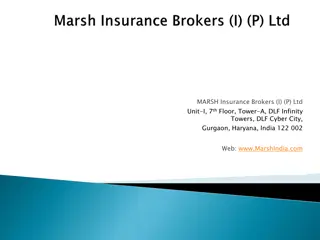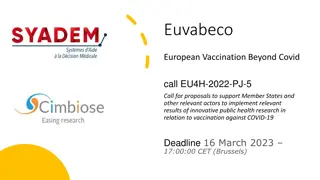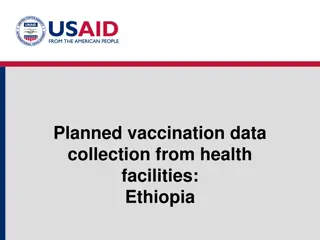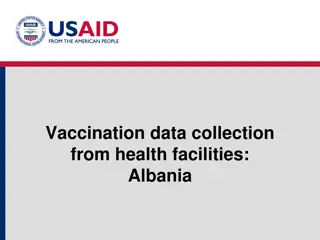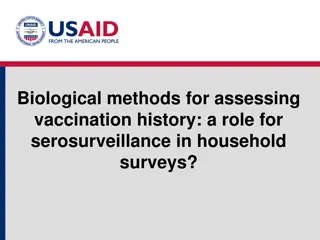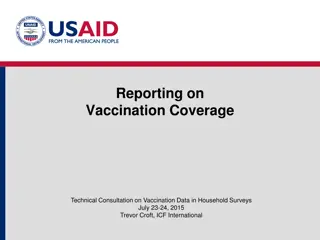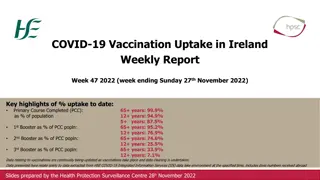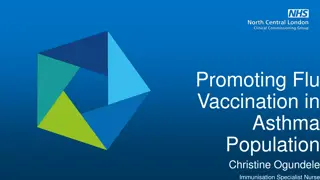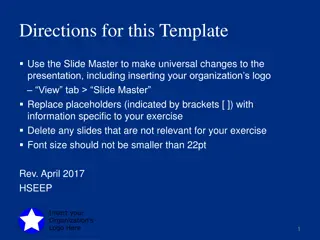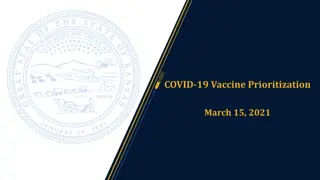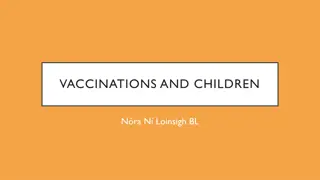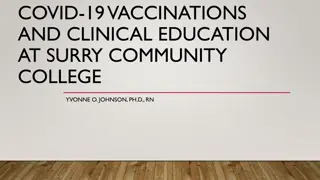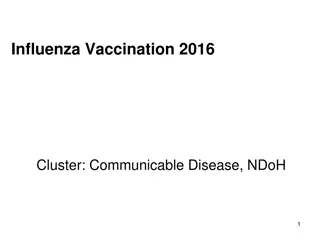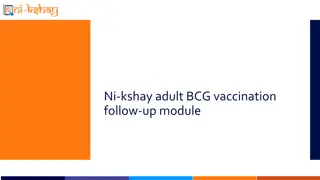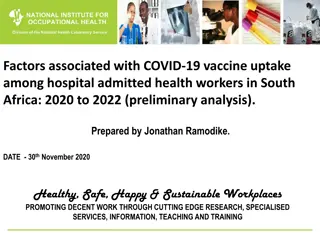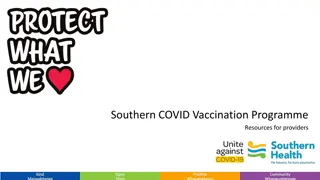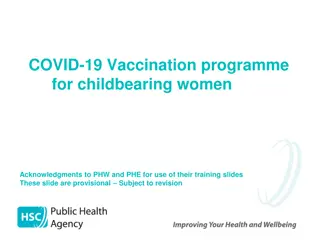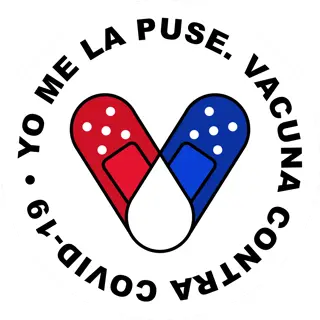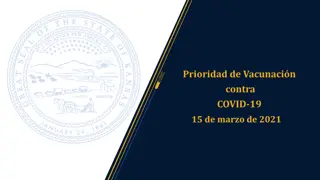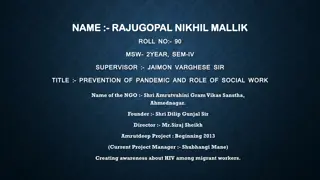Building Trust in Vaccination: A Comprehensive Training Module for Health Workers
This training module aims to equip health workers with the skills to address vaccine hesitancy effectively. It covers identifying hesitant individuals, engaging in conversations to build trust, and responding to concerns using motivational interviewing. Factors contributing to vaccine hesitancy and influences on vaccination decisions are discussed, emphasizing the importance of communication and understanding individual perspectives.
Download Presentation

Please find below an Image/Link to download the presentation.
The content on the website is provided AS IS for your information and personal use only. It may not be sold, licensed, or shared on other websites without obtaining consent from the author. Download presentation by click this link. If you encounter any issues during the download, it is possible that the publisher has removed the file from their server.
E N D
Presentation Transcript
Conversations to build trust in vaccination A training module for health workers May 2017 1
How to use this training module? The content in this training module is intended to be practical and adaptable for almost any setting. Prior to the training, we recommend that the programme manager/trainer adjust the content to allow for any local considerations. 2
Introduction In almost every community, there may be individuals who have lower levels of trust in vaccines, or may doubt or be indecisive about vaccination. These individuals may be considered to be hesitant . How do we identify them? How do we listen to and understand their concerns? How do we respond to their concerns in a helpful way? How do we help move them towards vaccination? 3
Learning objectives At the end of this training module, the participant will: Understand the key principles on communicating with vaccine hesitant individuals Learn skills to listen and engage in conversations aimed at building trust in vaccines Be able to respond to parental concerns regarding vaccine safety and effectiveness using motivational interviewing strategies Duration: 2 hours approximately 4
What is vaccine hesitancy? HESITANCY ACCEPT BUT UNSURE REFUSE BUT UNSURE ACCEPT SOME, DELAY AND REFUSE SOME ACCEPT ALL REFUSE ALL - A delay in acceptance or refusal of vaccines, despite availability of vaccination services - Complex and context specific, varying across time, place and vaccine 5
Factors contributing to vaccine hesitancy Complacency Low perceived risk of vaccine-preventable diseases, and vaccination not deemed necessary. Other life/health issues are a greater priority Convenience Barriers related to geographic accessibility, availability, affordability, and acceptability of services Confidence Low levels of trust in vaccines, in the delivery system, and in health authorities 6
What factors influence decisions about vaccination? Contextual Individual and group influences Vaccine/vaccination -specific issues Media and public communication Local politics Religion, culture Accessibility of services Trust in authorities Beliefs and attitudes about health and disease prevention Knowledge and awareness Poor quality health service experience Mode of administration Source of the vaccine Vaccination schedule Any costs associated with vaccination Knowledge/attitudes of healthcare professionals 7
Group discussion (5 minutes) Provide some SPECIFIC examples of vaccine hesitancy you may have come across in your community. 9
Addressing vaccine hesitancy No single strategy can address all of the different dimensions of hesitancy What health workers (HW) say and how they interact with the patient/caregiver can strongly influence vaccine acceptance This module focuses on evidence-informed best practices for HWs to increase vaccine acceptance through skilled conversation about vaccination. 10
Who might express vaccine hesitancy? It can be anyone, including but not limited to Pregnant Women Elderly Caregivers Adults Adolescents And others, e.g. religious leaders, media, health workers, etc. 11
How can a health worker identify hesitant individuals? Open the conversation with a presumptive statement or announcement, presenting vaccination as a default: Now it s time for Sarah s vaccines. Today we ll give Sarah her vaccines 12
Is the caregiver/patient hesitant? Examples of some responses HESITANCY ACCEPT BUT UNSURE REFUSE BUT UNSURE ACCEPT SOME, DELAY AND REFUSE SOME ACCEPT ALL REFUSE ALL I don t trust vaccines No, I m not sure this is right for my child/for me OK, I guess I ll vaccinate I don t know I have doubts I m ready 13
If hesitant, how to proceed? ACCEPT BUT UNSURE REFUSE BUT UNSURE ACCEPT SOME, DELAY AND REFUSE SOME REFUSE ALL ACCEPT ALL Accept all Vaccine hesitant Refuse all Do not dismiss from the clinic Not a debate - focus on their concerns Leave space for any discussion Offer to refer to other health professionals who can discuss further (if available) Explain their responsibilities if not accepting vaccination, e.g. not protected against diseases, may get ill, may need specialised health care , and to watch for signs and symptoms of diseases in the community. More points discussed later in the training. Offer positive encouragement: Thatis great! A conversation guided by the MOTIVATIONAL INTERVIEWING method Administer the vaccines 14
It is frequently observed that, incorrectly Hesitant caregivers/patients may be offered a response such as: - Vaccines are good for you. You must get them. (Directive) - You are wrong. Research supports vaccines. (Argumentative) Further, little or no time is spent on exploring the reasons and motivations behind the hesitancy about vaccination. This style of communication can contribute to DECREASING TRUST between the health workers and the caregivers/patients. Vaccine uptake does not improve 15
For conversations with hesitant individuals: Motivational interviewing - A method of interacting with patients - Aimed at exploring reasons for hesitancy and changing attitudes and behaviour Collaborative With a specific objective Patient-centred 16
What is the objective for the health worker? To move the caregiver to accept vaccination HESITANCY REFUSE BUT UNSURE ACCEPT BUT UNSURE REFUSE ALL ACCEPT SOME, DELAY AND REFUSE SOME ACCEPT ALL To move the caregiver/patient who is hesitant to accept vaccination, and increase vaccine uptake 17
1 2 3 4 5 If the individual is hesitant, proceed with the following 5 steps for a more effective conversation USING MOTIVATIONAL INTERVIEWING: Motivational interviewing has been used widely and proven to be an effective tool in producing behaviour change in other areas of health, e.g. physical illness. This training presents motivational interviewing methods adapted for the context of vaccination. 18
1 Ask open-ended questions Open questions using what , why , how , tell me to explore reasons behindhesitancy Close ended questions Answer is only a yes or no Open ended questions Answer goes beyond a simple yes or no Do you agree? What do you think? Did you understand? What did you understand? 19
Discussion (5 minutes) In pairs or groups of three Provide examples of other open-ended questions you could use. 20
1 2 Reflect and respond Simple reflection: directly repeating what the person says. Complex reflection: repeating what you think the person means. Caregiver: I know vaccinating will help my child but I am afraid. Simple reflection: I understand that you are afraid. Complex reflection: You want to make the best choice for your child but you are nervous. Use both types of statements to acknowledge concerns. 21
Discussion (5 minutes) In pairs or groups of three Provide examples of complex reflection and open questions to caregivers responses to the following scenarios. Patient: I know vaccinating will help me but I am afraid of side effects. community leader objects to vaccines. Father: I am not convinced about vaccines, so it seems like too much effort to come all the way to get them. Mother: I am not sure what to do because my 22
Responding to hesitancy: examples Complex reflection followed by open questions Patient: I know vaccinating will help me but I am afraid of side effects. I understand that you want to make the best choice for yourself. What side effects are you concerned about? 23
Responding to hesitancy: examples Complex reflection followed by open questions Mother: I am not sure what to do because my community leader objects to vaccines. I can see you may be questioning vaccines. How are other mothers you know dealing with vaccines? Other questions you can ask: - What are your concerns? - Do you know what your community leader is concerned about? 24
Responding to hesitancy: examples Complex reflection followed by open questions Father: I am not convinced about vaccines, so it seems like too much effort to come all the way to get them. Vaccination may be difficult to consider. What do you know about vaccines? Other questions you can ask: - Could I offer you some information on why we vaccinate? - What would it take in order for you to accept vaccination for your child? 25
1 2 3 Affirm the strengths It is great that you are starting to think about vaccines. Validate concerns The health of your children is important to you. Protecting yourself from illness is important for you and the health of your community. 26
1 2 3 4 Ask-Provide-Verify As the conversation evolves, explore the concerns further: Ask Verify Provide Ask information on what the client knows about vaccines Verify what they have understood and what they will do with this information Share information on vaccines Could I provide you with some information, based on what you just shared? So what do you already know about vaccination? Given our discussion, how do you view the decision now? Remember I am here to help talk through any concerns you may have. Please note: Be careful not to add potential concerns by mentioning issues not raised by the parent/caregiver. 27
1 2 3 4 5 Summarize the interaction The reason that s important is What that means to you is The main point to remember is . 28
1 2 3 4 5 Determine the action IF YES: Vaccinate and offer praise to affirm the positive decision. IF FOR FOLLOW-UP (if possible): Refer caregiver/patient to a specialist/community advocate or schedule a new discussion: Let s revisit this once you have had a chance to think more about vaccination. When could you come back? IF REFUSAL: Do not debate. Leave the door open: I understand. Please know that if you change your mind and want to talk about vaccinating, we are always available. 29
If the caregiver/patients wishes are NOT to vaccinate, ensure they understand their decision, and explain their responsibilities for protecting the health of their child/themselves. I understand that you have decided not to vaccinate today. Please know you are taking an important responsibility. What this means is 1) If your child/you are ill, you must seek medical assistance 2) When talking to medical/clinic staff, you must tell them that you/your child has not received all the vaccines recommended. 3) You must learn about the signs and symptoms of vaccine preventable diseases. Reference reading on caregiver roles and responsibilities for not accepting vaccines: http://www.euro.who.int/__data/assets/pdf_file/0004/160753/If-you- choose_EN_WHO_WEB.pdf?ua=1 (in English) 30
ROLE PLAYING (10-15 min) 5 minutes for role playing, 5 10 minutes for discussion in groups of 2 or more Person 1: Act as a vaccine hesitant individual who (pick one) Case 1: Is mildly reluctant to vaccinate themselves because friends advise against vaccines Case 2: Is very reluctant to vaccinate the child because mother-in- law says no to all vaccines Case 3: Does not want to immunize themselves and their child as no one in family has ever been vaccinated Case 4: Wants to debate and convince HW that vaccines are bad Person 2: Act as the health worker who is applying the principles of motivational interviewing Any other(s): Observers 31
Reminders DO Do take a guiding style. DON T Do not take a traditional directive and argumentative style. Do work with the parent/patient to establish trust. Do not identify and solve the problem for the parent/patient. Do explore doubts and interest in vaccination. Think from their perspective. Do not argue or debate with the client. Make it known that you are there to listen to their concerns. Do take time to reflect on what the caregiver/patient is saying. Rush through without listening 32
As you apply these skills, examples of questions to ask: 1. What do you think about vaccines? 2. What is your major concern? 3. What would it take to move you to a yes to vaccinate? 4. What could make it easier for you to get vaccines (on time) for yourself and/or your children? 33
When applying these approaches Always ADAPT the communication to YOUR setting Be sensitive to culture, social norms, religion, level of education, etc. 34
Other opportunities for building trust in vaccines Health workers can build trust in vaccines by being transparent and competent: Sharing data on diseases that can be prevented by vaccination Sharing information on safety and risk Explaining why vaccines are recommended and when (including schedules and doses) Vaccine manufacturing safety standards and national licensing Building trust in national decision- making processes Trust = Competence + Caring High Affection Trust CARING Distrust Respect Low High COMPETENCE 35
Emotions matter when building trust Remember to take into account the feelings and concerns of caregivers: Offer the time, space, and the environment for caregivers to digest information and ask questions Acknowledge and validate the perceptions of caregivers before advising them Demonstrate listening, be authentic and show you care Always tell the truth, even if admitting you do not know 36
Frequently asked questions BY HEALTH WORKERS How long should my conversation take with a vaccine hesitant individual? Guided conversations should take no more time than usual routine interactions, or perhaps 2-3 minutes longer We suggest focusing on one concern during your interaction, discussed in a competent and caring manner. If more time is needed, ask if the caregiver/patient can wait until after others are vaccinated, or book another visit (if feasible). More FAQs in Appendix A. 37
Frequently asked questions BY PATIENTS/CAREGIVERS SAFETY OF VACCINES Can vaccinations lead to infertility? No, vaccinations cannot lead to infertility. In fact, medical experts suggest that some vaccines actually protect fertility indirectly by preventing the need for treatment. Can vaccines cause harmful side effects, illness and even death? No, vaccines are very safe. Most side effects from vaccines are minor and temporary, such as a sore arm or mild fever. Serious adverse events or death are VERY rare (e.g. 1 per millions of doses) for most vaccines. Can needles used for immunization cause infection? For every vaccine, we always use one-time or auto-disable syringes that cannot be reused, which eliminates the risk of transmitting infections from needles. TIMING OF VACCINES Isn t giving three needles too many in one visit? No, receiving multiple vaccines in one visit is completely safe as you/your child s immune system is strong enough to handle them. 38 More FAQs in Appendix A.
Summary Conversations that guide the caregiver/patient to explore their reasons for hesitancy can help increase confidence and trust in vaccines and the vaccination programme. The goal of these conversations is to move someone towards a yes for acceptance. It may take more than one visit. Adequate training and practice can help lead to positive outcomes. 39
STEP-BY-STEP SUMMARY OVERVIEW Start with a presumptive statement: It s time for [name] s vaccines today . If hesitant, follow-up with a guided conversation: 1. Ask open ended questions What are your concerns about vaccinating? 2. Reflect and respond Caregiver: I know vaccinating will help by child but I am afraid. HW: I understand that you want to make the best choice for your child but are nervous.. 3. Affirm strengths and validate concerns Its great that you are starting to think about vaccines. The health of your children is important to you. 4. Ask-provide-verify So what do you already know about vaccines? Could I provide you with some information based on what you just shared? Given our discussion, how do you view things now? 5. Summarize and describe action What that means to you is Could I schedule a follow up appointment soon with our [doctor/pediatrician/expert]? 40
Appendix A COMMONLY ASKED QUESTIONS BY VACCINE HESITANT INDIVIDUALS 42
Wont breast feeding protect babies from infection? Yes, breast milk will give some protection against some infection, but it does not have the direct ability to prevent infection like vaccines. Vaccines are very specific to the given infection and their prevention capacity is very high. Can vaccines cause the infection they are supposed to prevent? Inactivated vaccines do not have live germs and cannot cause infections. Live vaccines have weakened germs that are unable to cause disease in healthy people. Rarely a mild form of infection may occur. 43
Is protection from natural infection more effective protection? Natural infection comes with the risks of serious complications related to that infection. With vaccines, the immune system is stimulated to develop protection without infection, hence it is more effective. Shouldn t vaccines be delayed until children are older and there is less risk of side effects? There is no evidence that side effects are more common in infants/babies than older children. Delaying vaccines leaves young children at risk of the disease and its complications. 44
